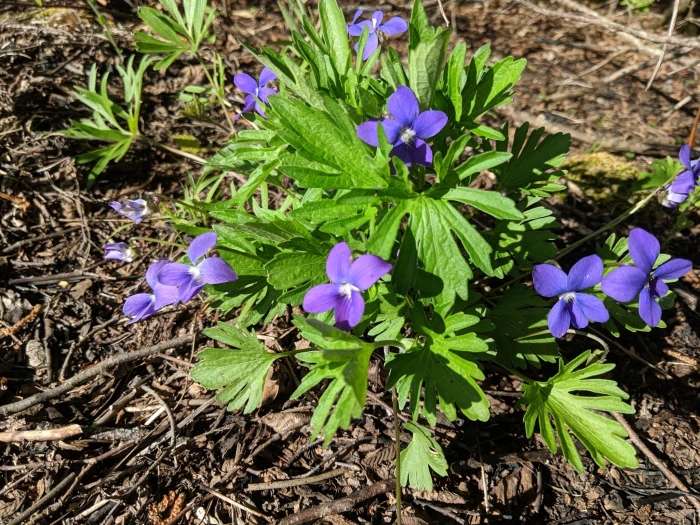Prairie Violet
(Viola pedatifida)
Prairie Violet (Viola pedatifida)
/
/

Ethan Rose
CC BY 4.0
Image By:
Ethan Rose
Recorded By:
Copyright:
CC BY 4.0
Copyright Notice:
Photo by: Ethan Rose | License Type: CC BY 4.0 | License URL: http://creativecommons.org/licenses/by/4.0/ | Rights Holder: Ethan Rose | Publisher: iNaturalist | Date Created: 2019-05-14T10:26:57-07:00 |















































Estimated Native Range
Climate Requirements for Fukui-shi, Japan
| This Plant | Your Site | Plant Suitability for Your Location | ||
|---|---|---|---|---|
| • Precipitation | 14" - 45" | 93" | Aquatic | Aquatic |
| • High Temp. | 71°F - 94°F | 88°F | Your summer temperatures are normal for this plant. | Excellent |
| • Low Temp. | -13°F - 24°F | 32°F | OK, but your winter temperatures are warmer than normal for this plant | OK |
This plant may not grow well at your location - your precipitation is too high.
Summary
Viola pedatifida, commonly known as Prairie Violet, is a perennial herbaceous plant native to prairie habitats, open woodlands, and grasslands in the central United States. It typically grows 5–30 cm (2.0–11.8 in) tall and is characterized by its violet flowers and 2–11 deeply divided leaves. As an acaulescent violet, it lacks leaves on the flowering stems. The Prairie Violet blooms from March to June, showcasing light violet flowers with the lower three petals white near the base, often adorned with hairs. After flowering, it produces ellipsoid capsules containing seeds during the summer months.
Prairie Violet is valued for its early spring blooms and its ability to attract pollinators such as bees and butterflies. It is often used in native plant gardens, rock gardens, and as a ground cover due to its low-growing habit and tolerance of a range of light conditions. This violet prefers full sun to part shade and medium water, thriving in well-drained soils. While it is not known for being particularly problematic, it can be susceptible to common violet pests and diseases.CC BY-SA 4.0
Prairie Violet is valued for its early spring blooms and its ability to attract pollinators such as bees and butterflies. It is often used in native plant gardens, rock gardens, and as a ground cover due to its low-growing habit and tolerance of a range of light conditions. This violet prefers full sun to part shade and medium water, thriving in well-drained soils. While it is not known for being particularly problematic, it can be susceptible to common violet pests and diseases.CC BY-SA 4.0
Plant Description
- Plant Type: Herb
- Height: 0.5-0.8 feet
- Width: 0.5-0.8 feet
- Growth Rate: Moderate
- Flower Color: Blue, Purple
- Flowering Season: Spring, Summer
- Leaf Retention: Deciduous
Growth Requirements
- Sun: Full Sun, Part Shade
- Water: Medium
- Drainage: Medium
Common Uses
Bee Garden, Butterfly Garden, Deer Resistant, Groundcover, Low Maintenance, Showy Flowers
Natural Habitat
Native to prairie habitats, open woodlands, and grasslands in the central United States
Other Names
Common Names: Crowfoot Violet, Larkspur Violet, Purple Prairie Violet, Violette Pédatifide, Prärieviol, Crow-Foot Violet
Scientific Names: Viola pedatifida, Viola palmata var. pedatifida, Viola delphinifolia, Viola pedatifida var. pedatifida, Viola indivisa, Viola delphiniifolia, Viola fallacissima, Viola pedatifida subsp. pedatifida, Viola pedatifida var. indivisa
GBIF Accepted Name: Viola pedatifida G.Don